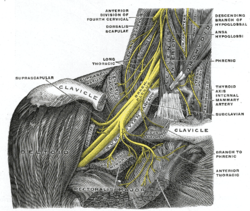| Dorsal scapular nerve | |
|---|---|
 The right brachial plexus with its short branches, viewed from in front. (Dorsalis scapulae labeled at left, second from top.) | |
| Details | |
| From | C5 of brachial plexus |
| Innervates | Rhomboid minor, rhomboid major, levator scapulae |
| Identifiers | |
| Latin | nervus dorsalis scapulae |
| TA98 | A14.2.03.011 |
| TA2 | 6409 |
| FMA | 65279 |
| Anatomical terms of neuroanatomy | |
The dorsal scapular nerve is a branch of the brachial plexus, usually derived from the ventral ramus of cervical nerve C5. It provides motor innervation to the rhomboid major muscle, rhomboid minor muscle, and levator scapulae muscle.
Contents
- Structure
- Origin
- Course and relations
- Function
- Clinical significance
- Dorsal scapular nerve syndrome
- See also
- Additional images
- References
- External links
Dorsal scapular nerve syndrome can cause a winged scapula, with pain and limited motion.
